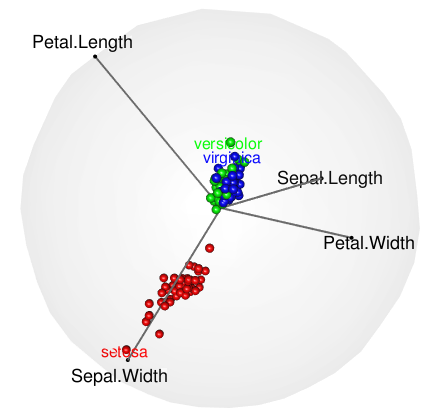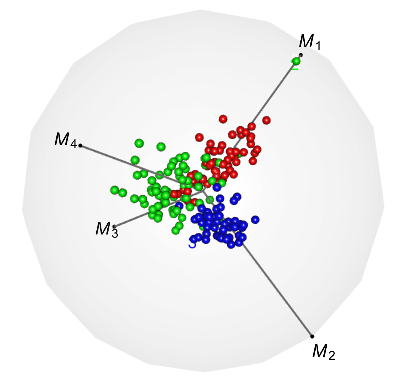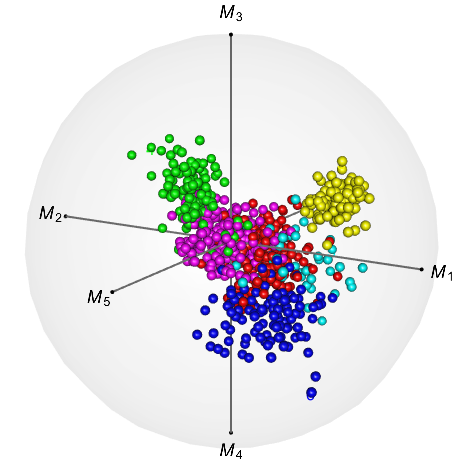
This package is developed for 3D radial visualization of high-dimensional datasets. Our display engine is called RadViz3D and extends the classic 2D radial visualization and displays multivariate data on the 3D space by mapping every record to a point inside the unit sphere. RadViz3D obtains equi-spaced anchor points exactly for the five Platonic solids and approximately for the other cases via a Fibonacci grid. We also propose a Max-Ratio Projection (MRP) method that utilizes the group information in high dimensions to provide distinctive lower-dimensional projections that are then displayed using Radviz3D. Our methodology is extended to datasets with discrete and mixed features where a generalized distributional transform (GDT) is used in conjuction with copula models before applying MRP and RadViz3D visualization. This document gives a brief introduction to the functions included in radviz3d with several application examples.
The 3D interative plots are implemented with the rgl
functions and here are instructions for manipulation: - Rotation: Click
and hold with the left mouse button, then drag the plot to rotate it and
gain different perspectives. - Resize: Zoom in and out with the scroll
wheel, or the right mouse button.
radviz3d contains 3 functions:
Gtrans: Transform discrete or mixture of discrete and
continuous datasets to continuous datasets with marginal
normal(0,1).mrp: Project high-dimensional datasets to lower
dimention with max-ratio projection.radialvis3d: Visualize appropriately tranformed
datasets in the unit sphere.The main function radialvis3d is able to displays and
classifies data points from the pre-known groups and provide visual
clues to how the grouped data are separately from each other.
We illustrate the usage of radialvis3d on datasets with
small (< 10) and large dimensions and with continuous or discrete
features. The interactive 3D plot are produced from rgl and
can be rotated manually to get better perspectives on
rgl-supported devices.
For small datasets with continuous values, function
radialvis3d can be applied directly with options
domrp = F and doGtrans = F. The 3D
plot below are displayed for the (Fisher’s or Anderson’s) iris data. The
dataset contains 50 flowers measurements for 4 variables, sepal length,
sepal width, petal length and petal width which are represented by the 4
anchor points in the plot. Flowers come from each of 3 species, Iris
setosa, Iris versicolor, and Iris virginica. Speicies groups are shown
in different colors and tagged with name labels.
library(radviz3d)
data("iris")
radialvis3d(data = iris[, -5], cl = factor(iris$Species), domrp = F, doGtrans = F,
lwd = 2, alpha = 0.05, pradius = 0.025, class.labels = levels(iris$Species))
For large datasets with continuous values, we use function
radialvis3d with options doGtrans = F and
domrp = T along with the number of principal components
k specified by npc = k. The plot for a wine
dataset are shown below. The dataset (reference link: ) contains 178
samples of three types of wines grown in a specific area of Italy. 13
chemical analyses were recorded for each sample.
radialvis3d(data = wine[, -14], cl = factor(wine[,14]), domrp = T, npc = 4, doGtrans = F,
lwd = 2, alpha = 0.05, pradius = 0.025, class.labels = levels(wine[,14]))
#> cumulative variance explained: 0.9913192 1 1 1 1 1 1 1 1 1 1 1 1
Datasets with discrete values can be transformed using options
doGtrans = T. (Currently, GDT is not applicable to
categorical variables). Here we present an example for an Indic scripts
dataset (reference link: ) which is on 116 different features from
handwritten scripts of 11 Indic languages. A subset of 5 languages is
chosen from 4 regions, namely Bangla (from the east), Gurmukhi (north),
Gujarati (west), and Kannada and Malayalam (languages from the
neighboring southern states of Karnataka and Kerala) and a sixth
language (Urdu, with a distinct Persian script). Some of the features
contains discrete values so the dataset is essentially of mixed
attributes. We apply radialvis3d with GDT and MRP
(npc = 6) to display for distinctiveness of samples
from each languages.
radialvis3d(data = script[,-117], cl = class, domrp = T, npc = 6, doGtrans = T,
lwd = 2, alpha = 0.05, pradius = 0.025, class.labels = levels(class))
#> cumulative variance explained: 0.3707163 0.6445103 0.8170576 0.9416525 1 1 1 1 1 1 1 1 1 1 1 1 1 1 1 1 1 1 1 1 1 1 1 1 1 1 1 1 1 1 1 1 1 1 1 1 1 1 1 1 1 1